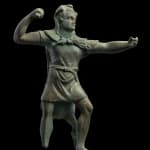Hellenistic
A Greek bronze figure of a ruler as Herakles possibly Ptolemy II or Antiochus IV, Hellenistic, circa 3rd-2nd century BC
Bronze
Height: 19 cm
Further images
In an active pose, his left leg advanced, his right arm raised brandishing his now missing club, the left arm extended in front, the skin of Nemean lion hooded over...
In an active pose, his left leg advanced, his right arm raised brandishing his now missing club, the left arm extended in front, the skin of Nemean lion hooded over his head, the forepaws tied at his neck, and then draped down his back, wearing a short tunic belted at his waist. The facial features are distinctly portrait and depict a Hellenistic ruler in the guise of Herakles, likely Ptolemy II or Antiochus IV.
Provenance
Gorny and Mosch, Munich, 18 December 2009, lot 20Private collection, acquired from the above
Literature
During this period, Herakles was particularly associated with Alexander the Great, who even claimed lineage from the hero and reputedly named a son after him. Alexander saw in Herakles the heroic, kingly, ideal image he sought to promote for himself.Despite the evident divine attributes, due to the inclusion of portrait features, this figure likely represents an individual. Following the death of Alexander the Great in 323 BC, his generals, known as the Diadochoi, that is, “successors,” divided the many lands of his empire into kingdoms of their own. New Hellenistic dynasties emerged—the Seleucids in the Near East, the Ptolemies in Egypt, and the Antigonids in Macedonia. The Successors, in an attempt to associate themselves with Alexander and legitimise their own rule followed in the artistic traditions he had created.
It is possible that this bronze figure depicts Ptolemy II or Antiochus IV, both Hellenistic kings and successors of Alexander the Great. Like Alexander, Ptolemy I Soter (and hence later Ptolemies) traced their lineage from Herakles. In the case of Ptolemy II Philadelphos, his ancestry is referred to by Theocritus in his 17th Idyll. Statues and coinage from this period maintained a standardised style with similar physiognomy, making it difficult at times to determine certain Hellenistic rulers apart.
For further discussion, see 'Not a Herakles, a Ptolemy', Antike Kunst, 33, Jahrg., H. 2., 1990, pp. 107-110.





